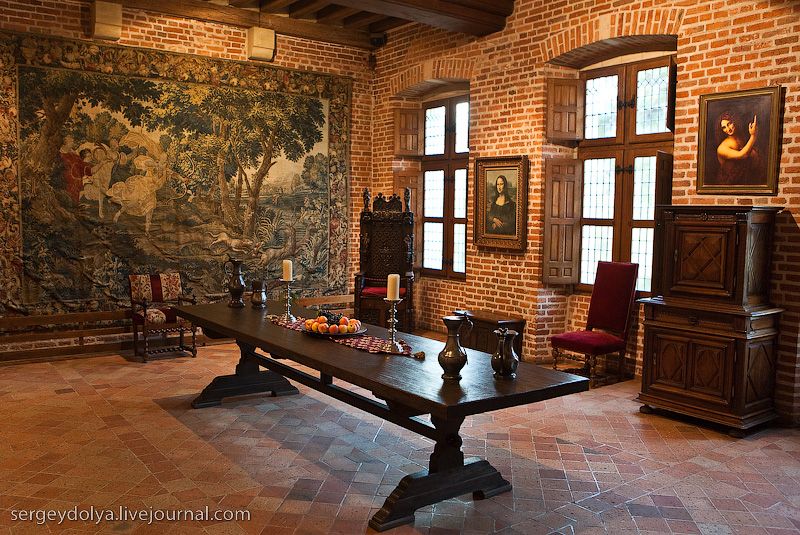|
|
Leonardo Da Vinci Castle
|
Until the 12th century, stone-built and earth and timber castles were contemporary, but by the late 12th century the number of castles being built went into decline. This has been partly attributed to the higher cost of stone-built fortifications, and the obsolescence of timber and earthwork sites, which meant it was preferable to build in more durable stone. Although superseded by their stone successors, timber and earthwork castles were by no means useless. This is evidenced by the continual maintenance of timber castles over long periods, sometimes several centuries; Owain Glyndŵr's 11th-century timber castle at Sycharth was still in use by the start of the 15th century, its structure having been maintained for four centuries.
In the late 12th century, there was a change in castle architecture. Until then, castles probably had few towers; a gateway with few defensive features such as arrowslits or a portcullis; a great keep or donjon, usually square and without arrowslits; and the shape would have been dictated by the lay of the land (the result was often irregular or curvilinear structures). The design of castles was not uniform, but these were features that could be found in a typical castle in the mid-12th century. By the end of the 12th century or the early 13th century, a newly constructed castle could be expected to be polygonal in shape, with towers at the corners to provide enfilading fire for the walls. The towers would have protruded from the walls and featured arrowslits on each level to allow archers to target anyone nearing or at the curtain wall. These later castles did not always have a keep, but this may have been because the more complex design of the castle as a whole drove up costs and the keep was sacrificed to save money. The larger towers provided space for habitation to make up for the loss of the donjon. Where keeps did exist, they were no longer square but polygonal or cylindrical. Gateways were more strongly defended, with the entrance to the castle usually between two half-round towers which were connected by a passage above the gateway – although there was great variety in the styles of gateway and entrances – and one or more portcullis. A peculiar feature of Muslim castles in the Iberian Peninsula was the use of detached towers, called Albarrana towers, around the perimeter as can be seen at the Alcazaba of Badajoz. Probably developed in the 12th century, the towers provided flanking fire. They were connected to the castle by removable wooden bridges, so if the towers were captured the rest of the castle was not accessible.
When seeking to explain this change in the complexity and style of castles, antiquarians found their answer in the Crusades. It seemed that the Crusaders had learned much about fortification from their conflicts with the Saracens and exposure to Byzantine architecture. There were legends such as that of Lalys – an architect from Palestine who reputedly went to Wales after the Crusades and greatly enhanced the castles in the south of the country – and it was assumed that great architects such as James of Saint George originated in the East. However, in the mid-20th century this view was cast into doubt. Legends were discredited, and in the case of James of Saint George, it was proven that he came from Saint-Georges-d'Espéranche, in France. If the innovations in fortification had derived from the East, it would have been expected for their influence to be seen from 1100 onwards, immediately after the Christians were victorious in the First Crusade (1096–1099), rather than nearly 100 years later. Remains of Roman structures in Western Europe were still upstanding in many places, some of which had flanking round-towers and entrances between two flanking towers. The castle builders of Western Europe were aware of and influenced by Roman design; late Roman coastal forts on the English "Saxon Shore" were reused and in Spain the wall around the city of Ávila imitated Roman architecture when it was built in 1091. It has been argued – by historian Smail in Crusading warfare – that the case for the influence of Eastern fortification on the West has been overstated, and that Crusaders of the 12th century in fact learned very little about scientific design from Byzantine and Saracen defences. A well-sited castle that made use of natural defences and had strong ditches and walls had no need for a scientific design. An example of this approach is Kerak. Although there were no scientific elements to its design, it was almost impregnable, and in 1187 Saladin chose to lay siege to the castle and starve out its garrison rather than risk an assault.
After the First Crusade, Crusaders who did not return to their homes in Europe helped found the Crusader states of the principality of Antioch, the County of Edessa, the Kingdom of Jerusalem, and the County of Tripoli. The castles they founded to secure their acquisitions were designed mostly by Syrian master-masons. Their design was very similar to that of a Roman fort or Byzantine tetrapyrgia which were square in plan and had square towers at each corner that did not project much beyond the curtain wall. The keep of these Crusader castles would have had a square plan and generally be undecorated. While castles were used to hold a site and control movement of armies, in the Holy Land some key strategic positions were left unfortified. Castle architecture in the East became more complex around the late 12th and early 13th centuries after the stalemate of the Third Crusade (1189–1192). Both Christians and Muslims created fortifications, and the character of each was different. Saphadin, the 13th-century ruler of the Saracens, created structures with large rectangular towers that influenced Muslim architecture and were copied again and again, however they had little influence on Crusader castles.
|
|









